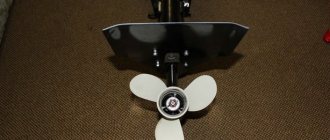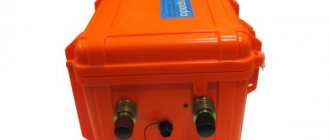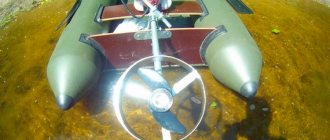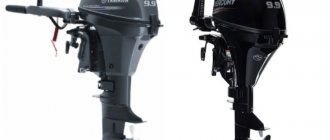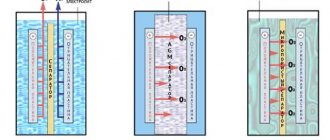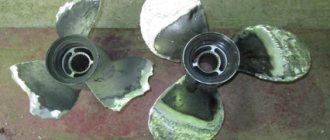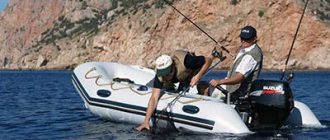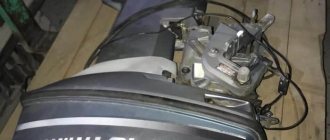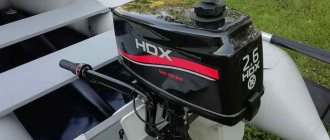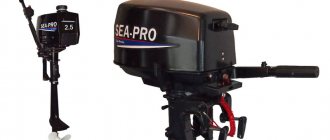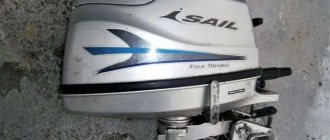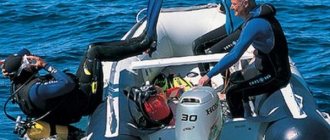Producing countries of outboard motors: Yamaha, Tohatsu, Mikatsu
Japan is known all over the world for its high production technologies. “Made in Japan” has already become a kind of guarantor of quality. It is for this reason that most lovers of powerboats prefer PLMs produced in the Land of the Rising Sun.
But is this really the case today? Yes, yes. Are all Japanese outboard motors made in Japan? This is what we will find out with you in this article.
Advertising is the engine of trade - this phrase is known to many. Well-structured marketing actively supports buyer interest in Japanese-made outboard motors, and a rich track record of reviews from thousands of users gives many the answer to whether it is worth buying Japanese equipment and overpaying for the brand. However, the information that the engines are “made in Japan” is only partly true.
The fact is that in Japan, from the mid-90s to this day, laws regarding environmental protection have been constantly tightening, which has served as the reason for many bans, including boat motors. Today in this country the production of two-stroke outboard motors is prohibited.
In Japan, there are management mechanisms aimed at developing health standards that contain emission limits for certain industries and types of production. The main body responsible for enforcing environmental legislation is the Department of Environmental Affairs, founded in 1971 and now holding ministerial status. Its activities include planning the main directions of state policy in the field of environmental protection, developing environmental laws, standards, regulations, and coordinating all environmental measures.
In November 1993, the Basic Law on the Environment was adopted. It became the foundation for environmental protection and formulated a position on the need to maintain a balance between economic activity and environmental conservation. The law was intended to ensure the support of public opinion in cases where economic measures are taken against those responsible for environmental pollution.
Based on this law, the government adopted a special environmental program in December 1994 aimed at creating a society that can support economic development while minimizing negative impacts on the environment.
In this regard, such well-known manufacturers as Yamaha, Tohatsu, Mercury and Suzuki are faced with stringent environmental requirements that set strict limits on the level of harmful emissions. And in connection with this, they were forced to transfer the production of two-stroke equipment to other countries in the South Asian region.
You can find information about the transfer of production of well-known brands of outboard boat motors to China by following these links:
Manufacturing countries of 2-stroke outboard engines Yamaha (Yamaha), Tohatsu (Tohatsu), Suzuki (Suzuki), Honda (Honda), Mikatsu (Mikatsu), Nissan Marine (Nissan Marine), Mercury (Mercury)
Yamaha boat motors
- – country of origin – Japan
- – assembly line – China
- – components, electrical, components – Japan.
- – plastic – China
- – spare parts and accessories – Japan
Boat motors Tohatsu (Tohatsu)
- – country of origin – Japan
- – assembly line – China
- – components, electrical, components – Japan.
- – plastic – China
- – spare parts and accessories – Japan
Suzuki boat motors
- – country of origin – Japan
- – assembly line – Thailand
- – components, electrical, components – China/Japan.
- – plastic – China
- – spare parts and accessories – China/Thailand.
Honda boat motors
- – country of origin – Japan
- – assembly line – China
- – components, electrical, components – China/Japan
- – plastic – China
- – spare parts and accessories – Japan
Mikatsu boat motors (Mikatsu)
- – country of origin – South Korea
- – assembly line – China
- – components, electrical, assemblies – Japan
- – plastic – China
- – spare parts and accessories – China/South Korea/Japan
Outboard motors Nissan Marine (Nissan Marine) (from 2021 - NS-Marine)
- – country of origin – Japan
- – assembly line – China/Taiwan
- – components, electrical, assemblies – Japan
- – plastic – China
- – spare parts and accessories – Japan
Mercury boat motors (Mercury) – Mercury plant*:
- – country of origin – Japan
- – assembly line – China/Taiwan
- – components, electrical, assemblies – Belgium/Mexico/China/Japan
- – plastic – China
- – spare parts and accessories – Belgium/Mexico/China/Japan
*Mercury engines for several years in the 90s and early 2000s were produced at the Tohatsu plant, which produced low-power engines up to 20 horsepower.
And even among four-stroke engines, there are brands that have moved their production to the Middle Kingdom, for example, Mercury boat engines, whose block assembly of four-stroke PLMs from 20 to 150 hp. carried out in China, Suzuki outboard motors, low-power Honda motors and some models of Nissan Marine (NS-Marine) motors.
How did the transfer of assembly of Japanese outboard motors of famous brands turn out for customers? Yes, by and large, nothing. After all, motors are assembled at licensed and constantly certified factories. Most of the components and blocks are still manufactured in Japan, and the transfer of assembly to other countries had virtually no effect on the quality of engine operation and their service life. But nevertheless, the warranty of many brands has been reduced from 5 to 1-3 years.
By purchasing engines from the Yamaha, Suzuki and Tohatsu brands that are popular, especially among Russian consumers, the buyer believes that he is purchasing equipment with a high engine life and will be able to operate it for many years. This is often true. But even if a manufacturing defect is discovered, the consumer does not face serious financial expenses, because Japanese engines are suitable for spare parts from manufacturers of other brands.
Based on the above, let's summarize some results. Outboard two-stroke outboard motors from Japan have only a formal relation to “Japanese quality” in the form of a sticker, although factories try to maintain the brand. No one can say what will happen in 3-5 years. Will Japanese brands, which are actually mostly assembled in China, be able to compete with their Chinese competitors, who sell equipment that costs half as much, but with not much inferior quality?
Let everyone answer this question for themselves.
We wish everyone to make the right choice when purchasing an outboard motor.
ORIGINAL SOURCE – https://rus-outboard.ru/Japanese-quality-with-Chinese-flavor/
Boat motors
Home » Boat motors
If you have a boat, but no outboard motor, then you are faced with a serious choice problem. On our website you will find information on almost all manufacturers of outboard motors. We will try to collect the most complete information on each motor model. The information is published as is and is for informational purposes only. Good luck with your choice.
- YAMAHA (Japan)
2-stroke YAMAHA outboard motors - 2-stroke YAMAHA outboard engines with separate oil injection
- 2-stroke outboard engines YAMAHA Enduro series
- 2-stroke YAMAHA Enduro series outboard engines running on kerosene
- YAMAHA 4-stroke outboard motors
- YAMAHA JET 4-stroke water jet outboard motors
- SUZUKI 2-stroke outboard motors
- 2-stroke outboard motors NISSAN MARINE
- TOHATSU 2-stroke outboard motors
- 4-stroke outboard motors HONDA
- PARSUN 2-stroke outboard motors
- HDX 2-stroke outboard motors
- 2-stroke outboard motors SAIL
- 2-stroke outboard motors SEA-PRO
- BELUGA 2-stroke outboard motors
- 2-stroke outboard motors SAILOR
- HIDEA 2-stroke outboard motors
- 2-stroke JET outboard motors
- 2-stroke DYNAMIC outboard motors
- 2-stroke outboard motors TROLL
- 2-stroke outboard motors SAIL
- 2-stroke outboard motors JETFORCE
- HASWING 2-stroke outboard motors
- 2-stroke outboard motors NEXUS
- 2-stroke outboard motors MTR MARINE
- ZONGSHEN 2-stroke outboard motors
- 2-stroke outboard motors MARLIN
- 2-stroke outboard motors MAGNUS
- 2-stroke outboard motors BALTMOTORS
- HANGKAI 2-stroke outboard motors
- YAMABISI 2-stroke outboard motors
- 2-stroke outboard motors GOLFSTREAM
- 2-stroke outboard motors WATERMAN
- 2-stroke TITAN outboard motors
- 2-stroke outboard motors GLADIATOR
- 2-stroke outboard motors POWERTEC
- 2-stroke outboard motors MERCURY
- 2-stroke outboard motors SELVA
- EVINRUDE E-TEC 2-stroke outboard motors
- JOHNSON 2-stroke outboard motors
- 2-stroke outboard motors NEPTUNE
- 2-stroke outboard motors VETEROK
- 2-stroke outboard motors VORTEX
- 2-stroke outboard motors SALYUT
- Jet outboard motors KALMAR
- MIKROSHA water-jet outboard motors
- Jet outboard motor STALKER - JET
- Jet outboard motors IMPULS
- 2-stroke outboard motors BIYSK
- 2-stroke outboard motors Strela
- 2-stroke outboard motors MOSCOW
- KAMA 2-stroke outboard motors
- 2-stroke outboard motors PRIBOI
- 2-stroke outboard motors PRIVET
- 2-stroke outboard motors CHAIKA
- 2-stroke outboard motors ZIF
- 2-stroke outboard motors SICH
- Electric motors NISSAMARAN
- Electric motors MINN KOTA ENDURA
- Electric motors MOTOR GUIDE FRESHWATER
- Electric motors TORQEEDO TRAVEL
- NAVIGATOR electric motors
- Electric motors WATERSNAKE
- Electric motors FLOVER
Where is a boat motor made - where are Yamaha, Mekury, Frigate, Mikatsu, Tohatsu motors made?
Many PLM buyers often want to know where outboard motors are made. We have compiled a rating of manufacturing countries, companies whose products are widely represented on the Russian market and, due to their quality, are, quite obviously, in high demand.
Yamaha
Yamaha outboard motors are of impeccable Japanese quality. These engines are manufactured by Yamaha Motor Co., Ltd., known for its products not only in Russia, but throughout the world. Where are Yamaha outboard motors assembled? Units with power up to 10 hp. are produced in Thailand, and over 10 hp. – in Japan, as well as in the USA. The company began manufacturing outboard motors more than half a century ago.
Today the manufacturer has reached heights in this matter. It produces both two-stroke and four-stroke models. Its products are distinguished by unsurpassed anti-corrosion protection characteristics, the presence of electronic injection, a microcomputer engine control system (depending on the model) and other parameters. All this allows you to be confident in the reliability and long-term operation of the units produced by the company.
Mercury
Mercury boat motors are produced by one of the leaders in the field of PLM manufacturing. The company's production facilities are located in several countries. Where are Mercury outboard motors assembled? They are produced in the USA, Japan, and China. Moreover, it is important to note that only three models are manufactured in China - 4-stroke engines 40/50/60 hp, while production is carried out in a modern, officially registered factory, with the same quality guarantee.
The Mercury brand has a history of more than 80 years. This brand appeared in the United States of America. The owners of the company went through a difficult path, which, after several decades, led them to success in the field of PLM production. Today, motors of this brand are popular among Russian consumers due to their excellent performance characteristics.
Fregat
Fregat boat motors are produced at a large PLM production plant. Initially, the company was engaged in the manufacture of boats, but later increased the number of its production areas and offered the buyer highly rated outboard engines.
Where are Fregat boat motors made? In China. Moreover, there is no need to doubt the quality of these Chinese products. This brand has more than enough recommendations. Today PLM Fregat are in demand due to the optimal price/quality ratio. Many owners of boats on which such motors are installed note that these engines are reliable and can operate without complaints for many years.
Mikatsu
In which country are Mikatsu outboard motors manufactured? In China. It should be noted that in Russia, motorcycle products of this brand are advertised as being manufactured in South Korea. According to the manufacturer, over the past few years, cases of defects have been practically eliminated, and less than 2% of customers have applied for warranty engine repair services.
Tohatsu
Engines for Tohatsu boats are products of a well-known brand, and not only in Russia. They are produced by Tohatsu Corporation. Where are Tohatsu outboard motors made? Exclusively in Japan, so to speak “Made in Japan 100%”. The company has existed for almost 100 years, but it did not immediately begin producing PLM. It was only in 1935 that the first boat engine was produced, but the company began the thorough production of units for boats much later.
Today, Tohatsu engines are popular among buyers who want to purchase a Japanese quality engine that will not let them down at the most crucial moment. The range of units of this brand is wide. Therefore, it is possible to choose the equipment that suits your specific requirements.
Conclusion
So, we answered the question “Where are boat motors of famous brands produced?” Of course, this is not a complete list; there are other popular brands. But we compiled this rating based on the number of questions regarding where boat motors are made. Therefore, the listed brands included Yamaha, Mercury, Frigate, Mikatsu, Tohatsu.
Tohatsu
Engines for Tohatsu boats are products of a well-known brand, and not only in Russia. They are produced by Tohatsu Corporation. Where are Tohatsu outboard motors made? Exclusively in Japan, so to speak “Made in Japan 100%”. The company has existed for almost 100 years, but it did not immediately begin producing PLM. It was only in 1935 that the first boat engine was produced, but the company began the thorough production of units for boats much later.
Today, Tohatsu engines are popular among buyers who want to purchase a Japanese quality engine that will not let them down at the most crucial moment. The range of units of this brand is wide. Therefore, it is possible to choose the equipment that suits your specific requirements.
Conclusion
So, we answered the question “Where are boat motors of famous brands produced?”
Of course, this is not a complete list; there are other popular brands. But we compiled this rating based on the number of questions regarding where boat motors are made. Therefore, the listed brands included Yamaha, Mercury, Frigate, Mikatsu, Tohatsu. Return to list
Where are Mercury, Yamaha, Suzuki, Honda, Tohatsu outboard motors made?
| Manufacturer | Model | Country of origin |
| Honda | All models except BF 2.3 | Japan (2.3 - Thailand) |
| Mercury | F40-F60 EFI | China since 2008 |
| Mercury | 2-stroke: 2.5M; 3.3M; 5M; 25 and 30 hp. 4-stroke: F2.5 - 3.5; F4-6; F9.9; F15-20; F25-30EFI | Japan |
| Mercury | 2-stroke:9.9M;15M;40-50-60-75-90 4-stroke: F80-115 EFI; F150 EFI OptiMax: 90-300hp Verado: 150-350hp | USA |
| Suzuki | 2-stroke: all 4-stroke models: from DF-2.5 to DF-20 (inclusive), DF-25 ARS, DF-30 new | Thailand |
| Suzuki | Other models | Japan |
| Tohatsu or Nissan | 2.5-8 (2 stroke), 2-3 hp. (4 measures) | China (according to some sources only Japan) |
| Tohatsu or Nissan | Other models | Japan |
| Yamaha | F4,F5,F6 | since 2015 Thailand |
| Yamaha | Other models | Japan |
Counterfeit Yamaha outboard motors
Counterfeit Yamaha outboard motors
How to identify counterfeit Yamaha outboard motors
The originality of a Japanese engine comes almost first when choosing a seller - the level of quality of the materials used, the presence of proprietary technologies and the accuracy of assembly and processing of parts depend on this factor. If “Yamaha” is written on the body, but in fact it is a fake Yamaha outboard motor, then the savings on the purchase price will not be justified. You should not think that the Chinese “analog”, which looks almost like the original product, is no different from a branded product. There are many differences, and they directly affect further operation, durability and convenience.
Where are Yamaha outboard motors made?
Around the mid-90s of the last century, the Japanese government decided to tighten environmental requirements, which shook the usual way of life in the ranks of industrial giants. This also affected the Yamaha conglomerate. After some time, the corporation decided to disperse its assembly lines to other countries - primarily China, Malaysia and Thailand. Also in the late 2000s, the production of four-stroke engines was partially transferred to France to reduce supply chains on the way to European consumers. Therefore, today the final assembly of units can be carried out in different parts of the world, including Japan itself. But in all these cases, the country of manufacture of Yamaha outboard motors is Japan. Since large-scale assembly takes place on the conveyor in compliance with the strict tolerances of Yamaha Corporation.
In other words, the buyer does not receive less quality in terms of assembly, since the same standards apply at all factories of the industrial empire, be it a line in Japan or Thailand. As for components and spare parts, they are all manufactured exclusively in the brand’s homeland, within the Yamaha Marine Group family (plant in Hamamatsu, Shizuoka Prefecture, about 200 miles southwest of Tokyo). In this way, the company only avoids the price costs of concentrating production on the Japanese islands without sacrificing quality.
How to recognize a fake Yamaha outboard motor
It’s not difficult to repeat the design of someone else’s product. It is enough to cast a body of the same shape and print cheap Yamaha stickers. Of course, a professional will quickly understand that this is not an original Yamaha. But for the average person, sometimes such a task seems overwhelming. So, let's go over the main signs of a fake motor.
- If you open the case (remove the casing), you can see that there are no company inscriptions. As mentioned above, all components are manufactured in Japanese facilities and are marked accordingly - engraved or imprinted with the brand name and model index. There is also a print with the “three tuning forks” emblem.
- A "no name" carburetor indicates that it is a fake. The original assembly on the case has a model number, as well as an ebb with the brand of a Japanese manufacturer, for example Keihin.
- The casting on the motor block must include a model index. The smooth walls of the block indicate that this is not the original.
- Even on the inner surface of the casing, the manufacturer, according to the standards, affixes a marking of belonging to a particular model. But the counterfeit manufacturer definitely won’t bother with such things.
It must be remembered that almost all Yamaha parts contain model markings, with the exception of bolts and nuts. This is the starting point when looking for differences. While stickers can be easily counterfeited, factory castings and prints remain an impregnable fortress for counterfeiters.
The appearance of the product, equipment and characteristics may be changed by the manufacturer without prior notice. This website is for informational purposes only and under no circumstances constitutes a public offer as defined by the provisions of Article 437 (2) of the Civil Code of the Russian Federation.
Where to buy spare parts
Spare parts for the Yamaha 9.9 GMHS outboard motor are expensive. They can be replaced with Chinese and Taiwanese counterparts, but the company does not guarantee proper quality. Aluminum screws are considered the most durable, but are too thick. Even after an impact, passengers will be able to swim to the shore while moving. Unlike competitors, the motor is easier to convert for remote control; it has many additional functions.
Yamaha 9.9 GMHS components:
● impact-resistant plastic tank;
● pump and hose for the fuel system;
● propeller;
● repair kit.
History of Yamaha outboard motors
| 1964 | A two-cylinder liquid-cooled outboard motor was developed. |
| 1971 | The performance of general purpose engines has been significantly improved. Active development of a service network for servicing Yamaha outboard motors in developing countries. |
| 1974 | The production of the E 15 A motor of the Enduro two-stroke outboard motor family has begun. |
| 1978 | Production of the three-cylinder Yamaha engine began. |
| 1981 | Production of V-shaped four-cylinder engines began. A system for adjusting the angle of inclination and trim of outboard motors has been developed. |
| 1983 | Production of V-shaped six-cylinder engines began. A precision boat engine system has been developed. A microprocessor motor control system has been developed. |
| 1984 | The production of the Yamaha F 9.9 CMHS four-stroke outboard motor has begun. An ignition timing control system has been developed. |
| 1985 | A system for changing the direction of rotation of the propeller has been developed. |
| 1988 | A multifunctional indicator device has been developed. |
| 1993 | Corrosion-resistant alloy YDC-30 developed |
| 1994 | The production of the 4-stroke four-cylinder outboard engine Yamaha F 50 DETL has begun. |
| 1995 | A multifunctional boat motor tiller has been developed. |
| 1996 | A device has been developed for washing outboard motors with fresh water. |
| 1997 | The OX66TM electronic injection system has been developed. |
| 1998 | Production of the Yamaha F 100 AETL 4-stroke, four-cylinder outboard motor has begun. Production of the Yamaha F 80 BETL 4-stroke, four-cylinder outboard motor has begun. |
| 1999 | A high pressure direct injection (HPDI) system has been developed. Production of V-shaped 6-cyl. began. Motor Z200N with HPDI system |
| 2000 | The production of the 4-stroke 4-cylinder Yamaha F 115 AETL engine with an electronic fuel injection system has begun. The production of the 4-stroke three-cylinder Yamaha F 40 BETS engine has begun. The production of six-cylinder engines Z175G and Z150P with the HPDI system has begun. The production of the FT9.9D 4-stroke two-cylinder engine with a deflection system, first used on outboard motors of this class, has begun. Production of 4-stroke 2-cylinder outboard engines Yamaha F 8 CMHS and Yamaha F 6 AMHS has been launched. |
| 2001 | The production of 4-stroke 6-cylinder engines Yamaha F 225 AETX and Yamaha F 200 AETX with an electronic fuel injection system and a camber angle of 60 degrees has begun. The production of the 4-stroke 4-cylinder outboard motor Yamaha F 60 AETL has begun. The production of the 4-stroke 2-cylinder outboard motor Yamaha FT8D has begun. The production of the 4-stroke 2-cylinder outboard motor Yamaha FT60B has begun. Production of 4-stroke 1-cylinder outboard motor Yamaha OHV F2.5A has begun |
| 2002 | The production of the V-shaped 6-cylinder engine Z250D with the HPDI system has begun. The 7 millionth outboard motor was produced. The production of 4-stroke four-cylinder outboard engines Yamaha F 150 AETL and F 150 AETX has begun. |
| 2003 | A V-shaped six-cylinder engine was introduced for the first time. The production of 4-stroke four-cylinder outboard engines Yamaha F 80 BETL, Yamaha F 60 CETL, Yamaha FT60D, Yamaha F 50 FETL with an electronic fuel injection system has begun. |
| 2004 | The production of the V-shaped 6-cylinder engine Z300B with the HPDI system has begun. |
| 2005 | The production of 4-stroke 4-cylinder outboard engines Yamaha F 100 DETL and Yamaha F 90 B with an electronic fuel injection system has begun. |
| 2006 | The production of the Yamaha F 250 AETX 4-stroke six-cylinder engine has begun, as well as the Yamaha FL 250 AETX reverse-rotating outboard motor with an electronic fuel injection system and a cylinder camber angle of 60 degrees. |
Determining the year of manufacture of a Yamaha outboard motor by serial number
| A | 1993 | 2014 |
| B | 1992 | 2013 |
| C | 1991 | 2012 |
| D | 1990 | 2011 |
| F | 1989 | 2010 |
| G | 1988 | 2009 |
| H | 1987 | 2008 |
| J | 1986 | 2007 |
| K | 1985 | 2006 |
| N | 1984 | 2005 |
| P | 1983 | 2004 |
| Q | 1982 | 2003 |
| R | 1981 | 2002 |
| S | 1980 | 2001 |
| T | 1979 | 2000 |
| U | 1978 | 1999 |
| V | 1977 | 1998 |
| W | 1976 | 1997 |
| X | 1975 | 1996 |
| Y | 1974 | 1995 |
| Z | 1973 | 1994 |
The year of manufacture of Yamaha outboard motors is encrypted with a letter in the lower left or right corner of the aluminum plate (on new motors there are stickers).
The correspondence between the letter and year of manufacture is indicated in the table. Please note that the letters are repeated every 21 years.
For example, if the letter T is indicated, then the engine could be produced in both 1979 and 2000. The manufacturers decided that by the appearance of the engine it would be possible to clearly determine whether it was produced in 1979 or 2000.
You can find the manufacturing date of the Yamaha motor on the side of the bracket designed to mount the outboard motor. It will consist of four digits in month/year format.
The most popular Yamaha boat motors Yamaha boat motors
Yamaha is a well-known manufacturer of various motor vehicles, including outboard boat motors, which have long won recognition due to their reliability and long service life. Since the assembly of outboard motors is carried out exclusively in Japan, they fully comply with the notorious “Japanese quality”. Yamaha produces two lines of outboard motors: 2-stroke and 4-stroke. Moreover, in both lines motors of a different spectrum are presented, starting from low-power motors with a power of 2 hp. and ending with motors with a capacity of 200-300 “horses”. Technological innovations are used in the design of the engines to reduce fuel consumption and noise levels, ensure ease of control and ease of operation of the engines, and also maximize their service life. Let's take a closer look at the most popular Yamaha engines.
Two-stroke
Among two-stroke engines, the most popular models are 5CMHS, 9.9GMHS and 30HMHS.
- Yamaha 5CMHS is the most powerful representative of the “low-power” segment of Yamaha outboard motors. The single-cylinder carburetor engine develops a power of 5 hp. and can be used in both deep water and shallow water thanks to its elevated position. It has a built-in 2.8 liter fuel tank with the ability to connect an external 12 liter tank, full reverse with the ability to rotate the body 180 degrees, a three-blade propeller and reduced noise. In order to resist corrosion, all parts of 5CMHS are made of specially treated stainless steel and YDC-30 alloy, which is considered the most corrosion-resistant. The motor weight is only 22 kg.
- Yamaha 9.9GMHS is a two-cylinder carburetor engine with a power of 9.9 hp* with a variable working deadwood angle. Due to the fact that it is made of light and durable aluminum alloy with unique anti-corrosion protection, the motor weight is only 36 kg. The engine has a capacitor CDI ignition system, protection against starting with the transmission engaged, an external fuel tank of 24 liters and a valveless intake-exhaust system on each cylinder. * Thanks to a displacement of 246 cm³, the Yamaha 9.9 can be converted into a 15 hp engine through simple manipulations.
- Yamaha 30HMHS is a universal two-cylinder carburetor engine with capacitor ignition with a power of 30 hp. It can be installed on a wide range of both inflatable and all-metal boats, and in terms of weight and efficiency it is comparable to 20-horsepower models from other manufacturers. The motor has liquid cooling, a 24-liter remote tank, and the ability to change the angle of inclination, which allows it to be used not only in deep water, but also in shallow water. The total weight of the 30HMHS is 53 kg.
Four-stroke
In the line of four-stroke engines, low-power outboard motors F4BMHS and F5BMHS, as well as models F9.9JMHS and F20BMHS/BES, enjoy well-deserved recognition.
- Yamaha F4BMHS is a single-cylinder carburetor engine with manual start and a capacitor CDI ignition system, developing a power of 4 hp. Its weight is only 27 kg including the propeller; the motor design includes a built-in 1.1 liter tank. If this is not enough, you can connect a remote tank of the required capacity. A special feature of engines of this series is an additional fuel pump that is installed in front of the carburetor. It is designed to make starting easier after long periods of storage.
- Yamaha F5BMHS is a 5-horsepower single-cylinder carburetor engine, almost completely similar to the above-mentioned model, with the exception of power. Moreover, its weight is also 27 kg.
- Yamaha F9.9JMHS is a two-cylinder carburetor engine with condenser ignition and overhead camshaft, developing a power of 9.9 hp. It is equipped with a 12-liter remote tank, a tilt angle system, a three-bladed propeller and a tiller handle. The motor is made of anti-corrosion material YDC-30 and zinc-plated stainless steel, so it is resistant to corrosion. The total weight is 40 kg.
- Yamaha F20BMHS/Yamaha F20BES is a powerful 20-horsepower two-cylinder engine with a CDI capacitor ignition system, Yamaha's patented PrimeStart™ starting system and gear start protection. It can be used not only in deep water, but also in shallow water, as it has a tilt angle adjustment mechanism. The BMHS model has manual control, and the BES has remote control and a generator, so its weight is 52 kg - 1 kg more than the model without a generator. Both engines are equipped with a 25-liter remote fuel tank.
Main selection criteria
There are a large number of selection criteria:
- number of cylinders;
- starting system;
- power (number of horsepower);
- planing mode;
- manufacturer;
- fuel consumption;
- additional functions;
- modes;
- number of cycles;
- fuel consumed;
- maintainability;
- control system;
- ease of maintenance;
- price.
As a rule, buyers pay attention to the cost, manufacturer and amount of horsepower.
By power
The models on the market have different capacities. In order for the boat to enter planing mode, the power must be 10-50 hp. With.
When choosing an engine, you need to take into account the following characteristics of the boat:
- luggage weight;
- your weight;
- number of passengers.
A properly selected model will ensure economical operation. In order to ensure high vehicle speed, you need to opt for more powerful models. Also, when choosing products, it is necessary to take into account the maximum permissible power for the boat.
Low power up to 5 hp
They are used for fishing in small bodies of water. In this case, the boat should not have increased speed indicators.
Key Features:
- have 1 cylinder;
- convenient for transportation;
- wear out when operating at full power;
- planing is not available;
- light weight;
- travel speed is 10-50 km/h;
- driving a vehicle without a license is permitted;
High power – from 6 hp and up to 60 hp
This product has a high cost. The average cost is 160-200 thousand rubles.
Used for different purposes:
- trips;
- competitions;
- hunting;
- extreme sport;
- patrolling.
As a rule, such models are installed on metal boats.
Characteristics:
- high maintainability;
- high fuel consumption;
- high oil consumption;
- high cost;
- for transportation you need to use a special trailer;
Models with such power can easily get the boat on plane.
By engine
All boat power units are divided into 2 categories
Two-stroke
Each category has both advantages and disadvantages. They also differ in technical characteristics and other parameters:
- have great power;
- high maintainability;
- light weight;
- simple design;
- a large number of spare parts;
- affordable price.
This product is intended for hunting, travel, industrial purposes and competitions.
Disadvantages:
- A mixture of gasoline and oil must be used as fuel.
- do not work well at idle;
- a large amount of harmful emissions;
- high noise.
Four-stroke
Characteristics:
- low noise;
- make the ride more comfortable;
- operate at low speeds;
- work at idle speed;
- environmental friendliness;
- suitable for various bodies of water;
- efficiency;
- undemanding to fuel quality;
- high reliability;
- low level of harmful emissions;
Flaws:
- expensive repairs;
- shortage of spare parts;
- complex design;
- low power;
- high probability of breakdowns;
- heavy weight;
- A trailer must be used for transportation.
By number of cylinders
All boat power units are divided into two-cylinder and single-cylinder. There is no significant difference between these product categories.
- Single cylinder. Single-cylinder gasoline engines allow you to travel at speeds of 5-10 km/h. Total weight is 15–20 kg.
- Two-cylinder. Two-cylinder gasoline engines allow you to travel at speeds of 10-100 km/h. The total weight is 30-40 kg.
Yamaha Outboard Engine Serial Number Location and Model Identification
- Serial number
- Model name
- Engine transom height
- Approved Model Code
The Yamaha Outboard Motor MODEL, PRELIMINARY USE and SERIAL NUMBER are stamped on a metal plate that is secured to the transom clamp bracket located at the rear of the boat.
When shopping online to locate and purchase Yamaha outboard engine parts and/or accessories from our online Yamaha OEM parts catalog, it is important to correctly identify the exact model you are dealing with when searching for the appropriate models online diagram.
The easiest way is with Yamaha outboards, as model records have changed over the years, making it difficult to correctly identify older outboards. However, this technical article shows the difference between serial number and model and shows where you can find them. We also have several other technical articles on Yamaha outboards that cover the topic of properly identifying Yamaha outboards.
Tags: Yamaha outboard motors, Yamaha outboard motors serial numbers
.
Choose outboard motors: find out availability, prices and buy online
The largest exporters from Russia, Kazakhstan, Uzbekistan, Belarus, official contacts of companies. Through our website, you can send a request to all representatives at once if you want to buy outboard motors.
